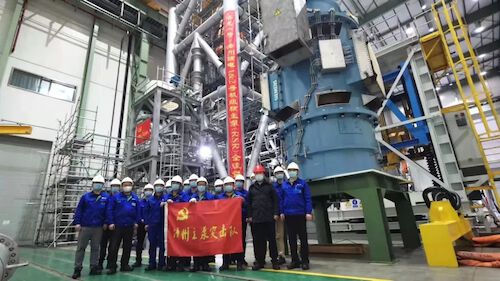At 4:00 a.m. on April 12, batch construction of the first unit of China's independent third-generation nuclear power plant "Hualong One", was undertaken by Shanghai Electric to manufacture the main pump of the nuclear island and the main equipment of the conventional island. It was the first unit of the CNNC Zhangzhou Nuclear Power Project. The full flow test of the main pump was successfully completed, and all parameters met the requirements of the test outline.
Zhangzhou project carries forward the strategic mission of developing China's independent third-generation nuclear power technology from competitor to the leadership position through Hualong’s take-off, integrating the technical route of "Hualong One" of CNNC and CGNPC. It will be the main models to follow in China that export million-level nuclear power projects overseas. "Hualong One" is an important achievement for China in accelerating the realization of high-level scientific and technological self-reliance and promoting the strategic goal of "carbon peaking and carbon neutrality." It will also be a national business card for China’s nuclear power going global, as it meets the requirements of the highest international standards in terms of security.
The nuclear island of Zhangzhou nuclear power plant is the first “Hualong One” reactor coolant pump manufactured by Shanghai Electric, which is of great significance. Shanghai Electric-KSB Nuclear Pump & Valve, a subsidiary of Shanghai Electric Nuclear Power Group (hereinafter referred to as Nuclear Pump Company), has independently and innovatively optimized the design of the shaft-seal coolant pump of Generation III Hualong One reactor, and fully verified its performance through the full-flow test. Besides the coolant pump, Shanghai Electric also supplied the conventional island turbine generator equipment, including the steam turbine, generator, condenser and other ancillary components. The condenser, as the first completed main component, was delivered in early February; the rest components are under intensive manufacturing, and the main ones are expected to be delivered in Q3 this year.
The COVID-19 tally continued to rise in Shanghai since March. However, the first coolant pump of Zhangzhou nuclear power project was at the critical stage for the full-flow test. To ensure the smooth progress of such a major national project, the Nuclear Pump Company launched many measures and acted proactively to develop a risk management plan in strict compliance with local epidemic prevention policies and on the premise of safeguarding staff health. The company established a working system with a standby responsible person for every post to ensure adequate work arrangements; meanwhile, it flexibly managed staff working in the plant and those working from home based on the epidemic control requirements of the industrial park, and has built an integrated communication system covering all online and offline channels to make full preparations for the test of reactor coolant pump. After the Shanghai Municipal Government issued the announcement on lockdowns in Pudong and Punan areas on the evening of March 27, the company immediately activated its risk management plan while meticulously carrying out COVID-19 prevention and control efforts. Twenty-six key persons related to the test worked under closed-loop management in the plant to ensure that the tasks would be carried out in an orderly and steady manner. During the period, they took on multiple jobs and supported each other in strict accordance with the relevant requirements to ensure sustainable production and operations during the outbreak. With the multi-tier management of personnel, materials and sites, they conducted comprehensive disinfection as well as the PCR testing and antigen testing for COVID-19 detection effectively; meanwhile, they swiftly set up a team for COVID-19 prevention and safety inspection to follow up the implementation of protective measures on a daily basis.
Although there were major challenges such as a lack of workforce during the process, the team made concerted efforts for the success of the test. In particular, during the 200-hour endurance test, the pump set had to run continuously without stopping; to monitor the process, all team members took the initiative to assume responsibilities. When they were tired, they took a short break on the floor; they actively sought solutions together with staff working at home whenever unexpected problems occurred, even after midnight. Finally, with their unwavering commitment, the development of test stand and other tasks were completed 2 days in advance compared with their plan.






 Shanghai PNS registry No. 31010102007087
Shanghai PNS registry No. 31010102007087